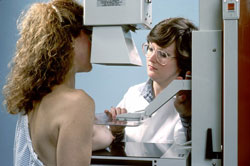Higher intake of vitamin D may reduce breast cancer risk

While these levels are higher than traditional intakes, they are largely in a range deemed safe for daily use in a December 2010 report from the National Academy of Sciences Institute of Medicine.
"We found that daily intakes of vitamin D by adults in the range of 4000-8000 IU are needed to maintain blood levels of vitamin D metabolites in the range needed to reduce by about half the risk of several diseases - breast cancer, colon cancer, multiple sclerosis, and type 1 diabetes," said Cedric Garland, DrPH, professor of family and preventive medicine at UC San Diego Moores Cancer Centre. "I was surprised to find that the intakes required to maintain vitamin D status for disease prevention were so high - much higher than the minimal intake of vitamin D of 400 IU/day that was needed to defeat rickets in the 20th century."
Not surprised
"I was not surprised by this" said Robert P. Heaney, MD, of Creighton University, a distinguished biomedical scientist who has studied vitamin D need for several decades. "This result was what our dose-response studies predicted, but it took a study such as this, of people leading their everyday lives, to confirm it."
The study reports on a survey of several thousand volunteers who were taking vitamin D supplements in the dosage range from 1000 to 10 000 IU/day. Blood studies were conducted to determine the level of 25-vitamin D - the form in which almost all vitamin D circulates in the blood.
"Most scientists who are actively working with vitamin D now believe that 40 to 60 ng/ml is the appropriate target concentration of 25-vitamin D in the blood for preventing the major vitamin D-deficiency related diseases, and have joined in a letter on this topic," said Garland. "Unfortunately, according a recent National Health and Nutrition Examination Survey, only 10% of the US population has levels in this range, mainly people who work outdoors."
Interest in larger doses was spurred in December of last year, when a National Academy of Sciences Institute of Medicine committee identified 4000 IU/day of vitamin D as safe for every day use by adults and children nine years and older, with intakes in the range of 1000-3000 IU/day for infants and children through age eight years old.
While the IOM committee states that 4000 IU/day is a safe dosage, the recommended minimum daily intake is only 600 IU/day.
"Now that the results of this study are in, it will become common for almost every adult to take 4000 IU/day," Garland said. "This is comfortably under the 10 000 IU/day that the IOM Committee Report considers as the lower limit of risk, and the benefits are substantial." He added that people who may have contraindications should discuss their vitamin D needs with their family doctor.
"Now is the time for virtually everyone to take more vitamin D to help prevent some major types of cancer, several other serious illnesses, and fractures," said Heaney.
Source: University of California








